Adaptive Machining Method for Helical Milling of Carbon Fiber-Reinforced Plastic/Titanium Alloy Stacks Based on Interface Identification
Abstract
1. Introduction
2. Materials and Methods
2.1. Machining Principle of the Helical Milling Method
2.2. Adaptive Method Based on Interface Identification
2.2.1. Portable Helical Milling Equipment
2.2.2. Machining Characteristics of the Pneumatic Spindle
2.2.3. Interface Identification and Adaptive Machining Principles
3. CFRP/Ti Stack Helical Milling Experiment
3.1. Construction of the Experimental Platform
3.2. Design of the Experiment
4. Results and Discussion
4.1. Accuracy of Interface Identification
4.2. Hole Diameter Accuracy
4.3. Hole Machining Quality
4.4. Analysis of Cutting Tool Wear
5. Conclusions
- (1)
- The machining mechanism of the helical milling method is investigated, the portable helical milling equipment is independently developed, and the spindle speed real-time feedback monitoring module is designed, so as to achieve the real-time reading of the spindle speed and the monitoring of the machining status of the equipment. Meanwhile, the interface identification method for the helical milling of CFRP/Ti stacks is proposed based on the characteristic that the spindle speed of the pneumatic spindle decreases with an increase in the torque applied to the spindle under the condition of constant input air pressure.
- (2)
- A new adaptive machining method for the helical milling of CFRP/Ti stacks is further proposed based on the presented interface identification method. Using a machining experiment, theoretical calculation, and fitting analysis, the threshold values for the interface identification and adaptive adjustment of the machining parameters are determined, and the algorithmic logic and procedure of the method are established. The adaptive machining method for the helical milling of CFRP/Ti stacks based on interface identification takes full account of the complexity in the machining process of laminated components, without the need to clarify the specific thickness of each material layer. It is not sensitive to the thickness uniformity of the stacked layers and manufacturing errors, so the machining scope of application is much wider.
- (3)
- Helical milling experiments of CFRP/Ti stacks are carried out, and analyzing the results, it is found that there is good agreement between the identified and monitored machined interface positions using the proposed method and the theoretical interface positions, which indicates that the proposed interface identification method has a high degree of accuracy. In addition, compared with the conventional constant parameter machining method, the proposed adaptive machining method for the helical milling of CFRP/Ti stacks based on interface identification results in higher hole-making accuracy and interlayer hole diameter consistency, as well as a significant improvement in the hole-making quality and wear of the cutting tool. This demonstrates the machining advancement and superiority of the proposed method.
Author Contributions
Funding
Institutional Review Board Statement
Informed Consent Statement
Data Availability Statement
Conflicts of Interest
References
- Zębala, W. Tool deflection in the milling of titanium alloy: Case study. Proc. SPIE 2015, 9662, 96624. [Google Scholar] [CrossRef]
- Ramulu, M.; Branson, T.; Kim, D. A study on the drilling of composite and titanium stacks. Compos. Struct. 2001, 54, 67–77. [Google Scholar] [CrossRef]
- Kyung, H.P.; Aaron, B.; Dave, K.; Patrick, K.; Jeff, L. Tool wear in drilling of composite/titanium stacks using carbide and polycrystalline diamond tools. Wear 2011, 271, 11–12. [Google Scholar] [CrossRef]
- Liu, J.; Shao, X.; Liu, Y.; Liu, Y.; Yue, Z. The Effect of Holes Quality on Fatigue Life of Open Hole. Mater. Sci. Eng. A 2007, 467, 8–14. [Google Scholar] [CrossRef]
- Ezugwu, E.O.; Bonney, J.; Yamane, Y. An overview of the machinability of aeroengine alloys. J. Mater. Process. Technol. 2003, 134, 233–253. [Google Scholar] [CrossRef]
- Stone, R.; Krishnamurthy, K. A neural network thrust force controller to minimize delamination during drilling of graphite-epoxy laminates. Int. J. Mach. Tools Manuf. 1996, 36, 985–1003. [Google Scholar] [CrossRef]
- Dandekar, C.R.; Shin, Y.C. Modeling of machining of composite materials: A review. Int. J. Mach. Tools Manuf. 2012, 57, 102–121. [Google Scholar] [CrossRef]
- Ezugwu, E.O.; Wang, Z. Titanium alloys and their machinability—A review. J. Mater. Process. Technol. 1997, 68, 262–274. [Google Scholar] [CrossRef]
- Yashiro, T.; Ogawa, T.; Sasahara, H. Temperature measurement of cutting tool and machined surface layer in milling of CFRP. Int. J. Mach. Tools Manuf. 2013, 70, 63–69. [Google Scholar] [CrossRef]
- Franczyk, E.; Zębala, W. Optimization of Titanium Alloy Drilling to Minimize the Secondary Burr after Deburring Process. Materials 2022, 15, 8432. [Google Scholar] [CrossRef]
- Brinksmeier, E.; Janssen, R. Drilling of Multi-Layer Composite Materials Consisting of Carbon Fiber Reinforced Plastics (CFRP), Titanium and Aluminum Alloys. CIRP Ann. 2002, 51, 87–90. [Google Scholar] [CrossRef]
- Kim, D.; Ramulu, M. Study on the Drilling of Titanium/Graphite Hybrid Composites. ASME J. Eng. Mater. Technol. 2007, 129, 390–396. [Google Scholar] [CrossRef]
- Iyer, R.; Koshy, P.; Ng, E. Helical milling: An enabling technology for hard machining precision holes in AISI D2 tool steel. Int. J. Mach. Tools Manuf. 2007, 47, 205–210. [Google Scholar] [CrossRef]
- Olvera, D.; de Lacalle, L.N.L.; Urbikain, G.; Lamikiz, A.; Rodal, P.; Zamakona, I. Hole making using ball helical milling on titanium alloys. Mach. Sci. Technol. 2012, 16, 173–188. [Google Scholar] [CrossRef]
- Sharif, S.; Rahim, E.A. Performance of coated- and uncoated-carbide tools when drilling titanium alloy—Ti–6Al4V. J. Mater. Process. Technol. 2007, 185, 72–76. [Google Scholar] [CrossRef]
- Smith, I.J.; Gillibrand, D.; Brooks, J.S.; Münz, W.-D.; Harvey, S.; Goodwin, R. Dry cutting performance of HSS twist drills coated with improved TiAlN. Surf. Coat. Technol. 1997, 90, 164–171. [Google Scholar] [CrossRef]
- Robson, B.D.P.; Lincoln, C.B.; Anderson, P.P.; Ferreira, J.R.; Davim, J.P. A review of helical milling process. Int. J. Mach. Tools Manuf. 2017, 120, 27–48. [Google Scholar] [CrossRef]
- Denkena, B.; Boehnke, D.; Dege, J.H. Helical milling of CFRP–titanium layer compounds. CIRP J. Manuf. Sci. Tec. 2008, 1, 64–69. [Google Scholar] [CrossRef]
- Voss, R.; Henerichs, M.; Kuster, F. Comparison of conventional drilling and orbital drilling in machining carbon fibre reinforced plastics (CFRP). CIRP Ann. 2016, 65, 137–140. [Google Scholar] [CrossRef]
- Kim, G.; Lee, K. Critical thrust force at propagation of delamination zone due to drilling of FRP/metallic strips. Compos. Struct. 2005, 69, 137–141. [Google Scholar] [CrossRef]
- Geng, D.; Liu, Y.; Shao, Z.; Lu, Z.; Zhang, D. Delamination formation, evaluation and suppression during drilling of composite laminates: A review. Compos. Struct. 2019, 216, 168–186. [Google Scholar] [CrossRef]
- Li, Z.; Liu, Q.; Ming, X.; Wang, X.; Dong, Y. Cutting force prediction and analytical solution of regenerative chatter stability for helical milling operation. Int. J. Adv. Manuf. Technol. 2014, 73, 433–442. [Google Scholar] [CrossRef]
- Shang, S.; Qin, X.; Li, J.; Li, S.; Li, H.; Huang, T.; Jin, Y.; Sun, D. Modelling of cutting forces and researching calibration method in helical milling. Int. J. Adv. Manuf. Technol. 2018, 94, 2949–2960. [Google Scholar] [CrossRef]
- Wang, B.; Wang, Y.; Zhao, H.; Wang, M.; Sun, L. Mechanisms and evaluation of the influence of cutting temperature on the damage of CFRP by helical milling. Int. J. Adv. Manuf. Technol. 2021, 113, 1887–1897. [Google Scholar] [CrossRef]
- Li, Z.; Liu, Q. Surface topography and roughness in hole-making by helical milling. Int. J. Adv. Manuf. Technol. 2013, 66, 1415–1425. [Google Scholar] [CrossRef]
- Rahim, E.; Mohid, Z.; Jamil, M.; Mat, K.; Koyasu, R.; Sasahara, H. Experimental study of helical milling on CFRP (carbon fibre reinforced polymer) for the hole making process. Adv. Mater. Res. 2012, 576, 68–71. [Google Scholar] [CrossRef]
- Brinksmeier, E.; Fangmann, S.; Meyer, I. Orbital drilling kinematics. Prod. Eng. 2008, 2, 277–283. [Google Scholar] [CrossRef]
- Bolar, G.; Sridhar, A.; Ranjan, A. Drilling and helical milling for hole making in multi-material carbon reinforced aluminum laminates. Int. J. Lightweight Mater. Manuf. 2022, 5, 113–125. [Google Scholar] [CrossRef]
- Zhou, L.; Ke, Y.; Dong, H.; Chen, Z.; Gao, K. Hole diameter variation and roundness in dry orbital drilling of CFRP/Ti stacks. Int. J. Adv. Manuf. Technol. 2016, 87, 811–824. [Google Scholar] [CrossRef]
- He, G.; Li, H.; Jiang, Y.; Qin, X.; Zhang, X.; Guan, Y. Helical milling of CFRP/Ti-6Al-4V stacks with varying machining parameters. Trans. Tianjin Univ. 2015, 21, 56–63. [Google Scholar] [CrossRef]
- Wang, G.; Suntoo, D.; Li, N.; Peng, T.; Li, Y. Experimental research in CFRP/Ti stack through different helical milling strategies. Int. J. Adv. Manuf. Technol. 2018, 98, 3251–3267. [Google Scholar] [CrossRef]
- Pan, Z.; Fang, Q.; Ke, Y.; Xu, G.; Han, B. A Force Sensorless Method for CFRP/Ti Stack Interface Detection during Robotic Orbital Drilling Operations. Math. Probl. Eng. 2015, 2015, 952049. [Google Scholar] [CrossRef]
- Neugebauer, R.; Ben-Hanan, U.; Ihlenfeldt, S.; Wabner, M.; Stoll, A. Acoustic emission as a tool for identifying drill position in fiber-reinforced plastic and aluminum stacks. Int. J. Mach. Tools Manuf. 2012, 57, 20–26. [Google Scholar] [CrossRef]
- Wang, H.; Qin, X.; Li, H.; Tan, Y. A comparative study on helical milling of CFRP/Ti stacks and its individual layers. Int. J. Adv. Manuf. Technol. 2016, 86, 1973–1983. [Google Scholar] [CrossRef]
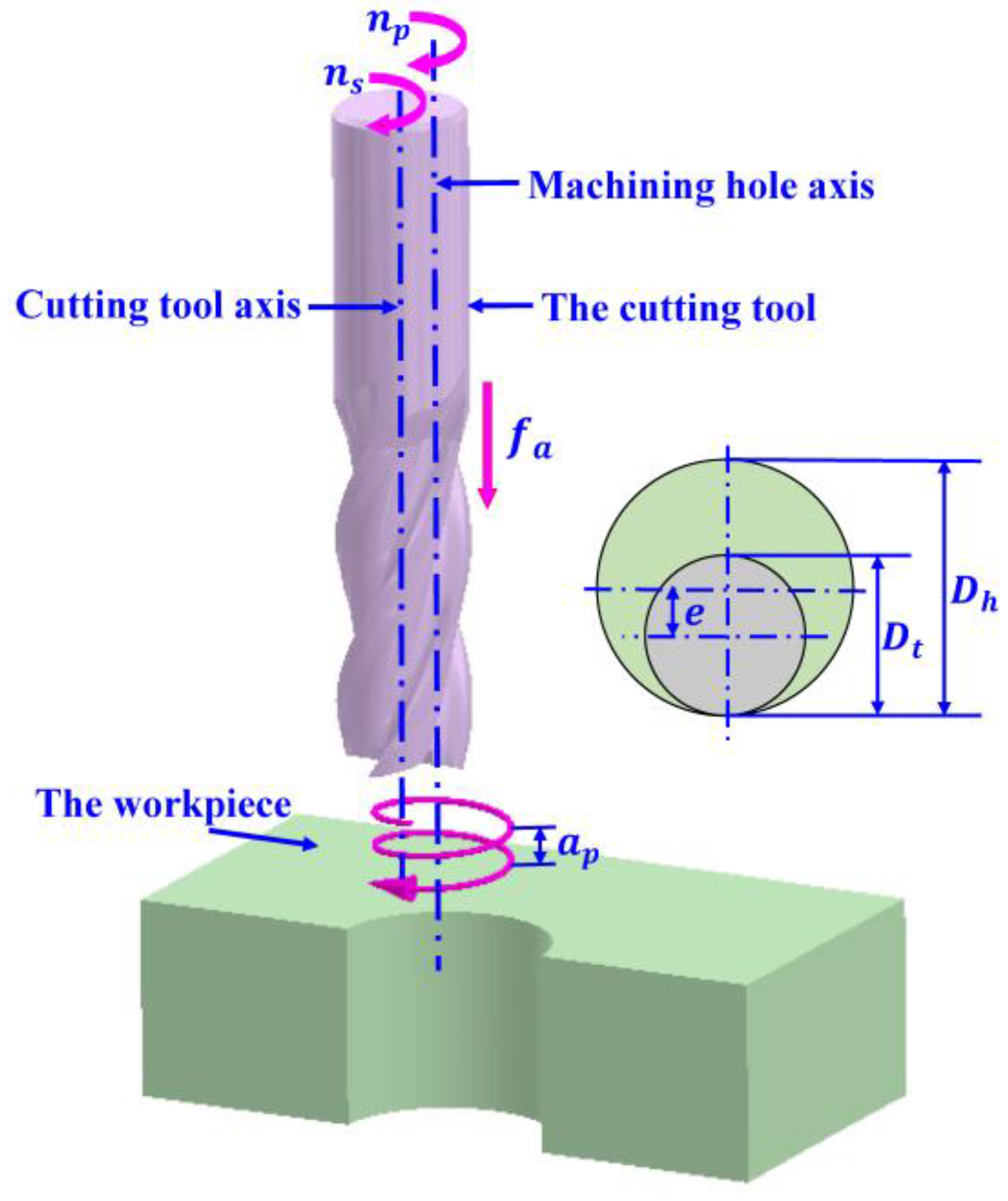
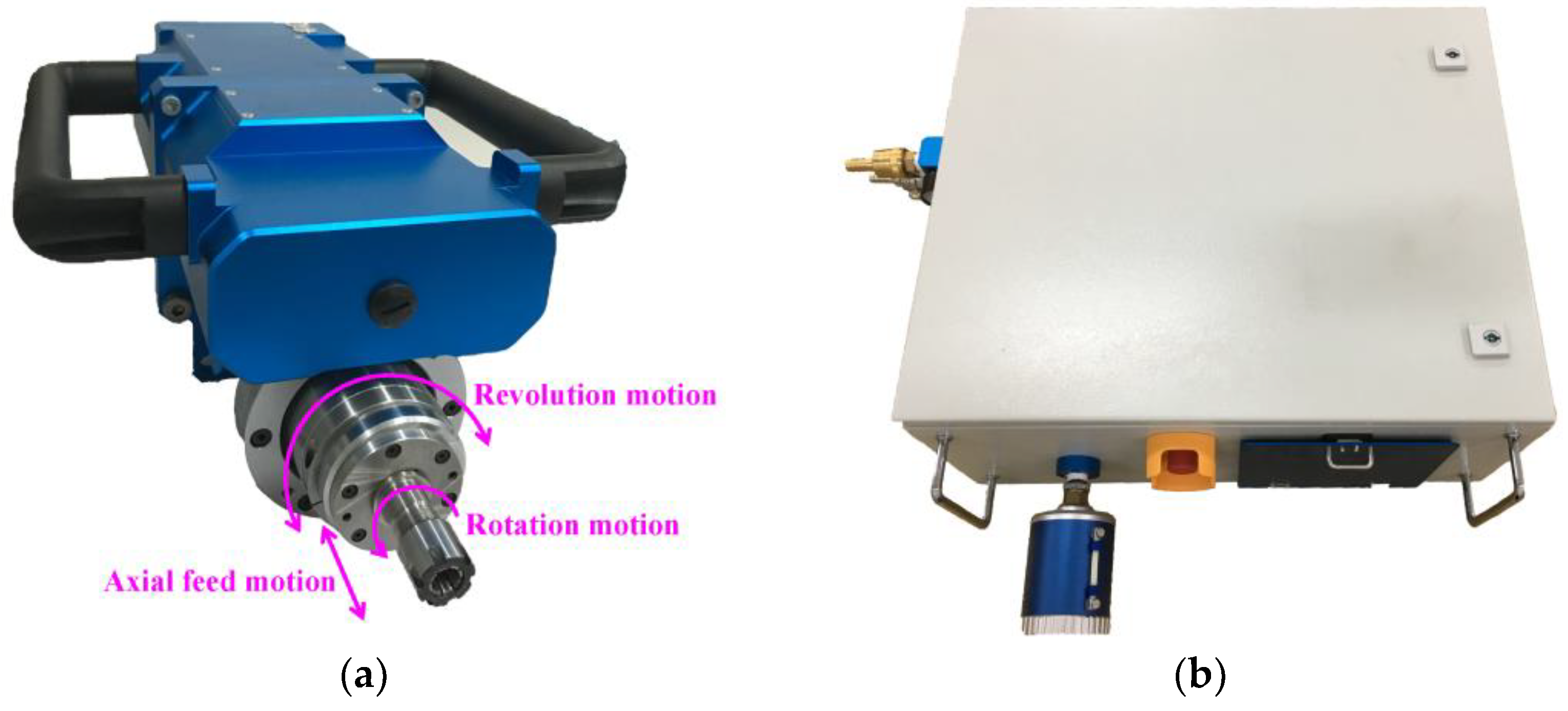
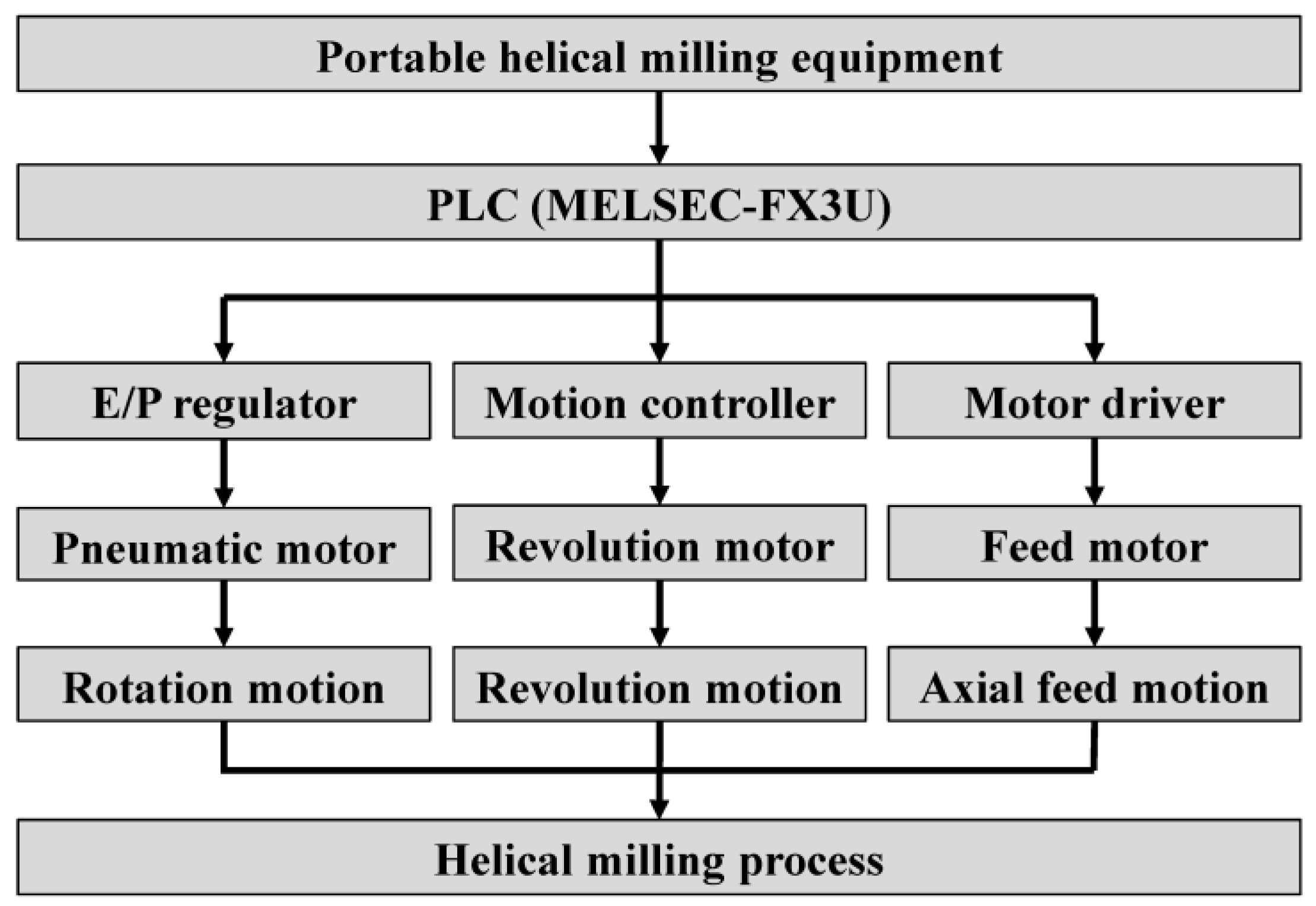
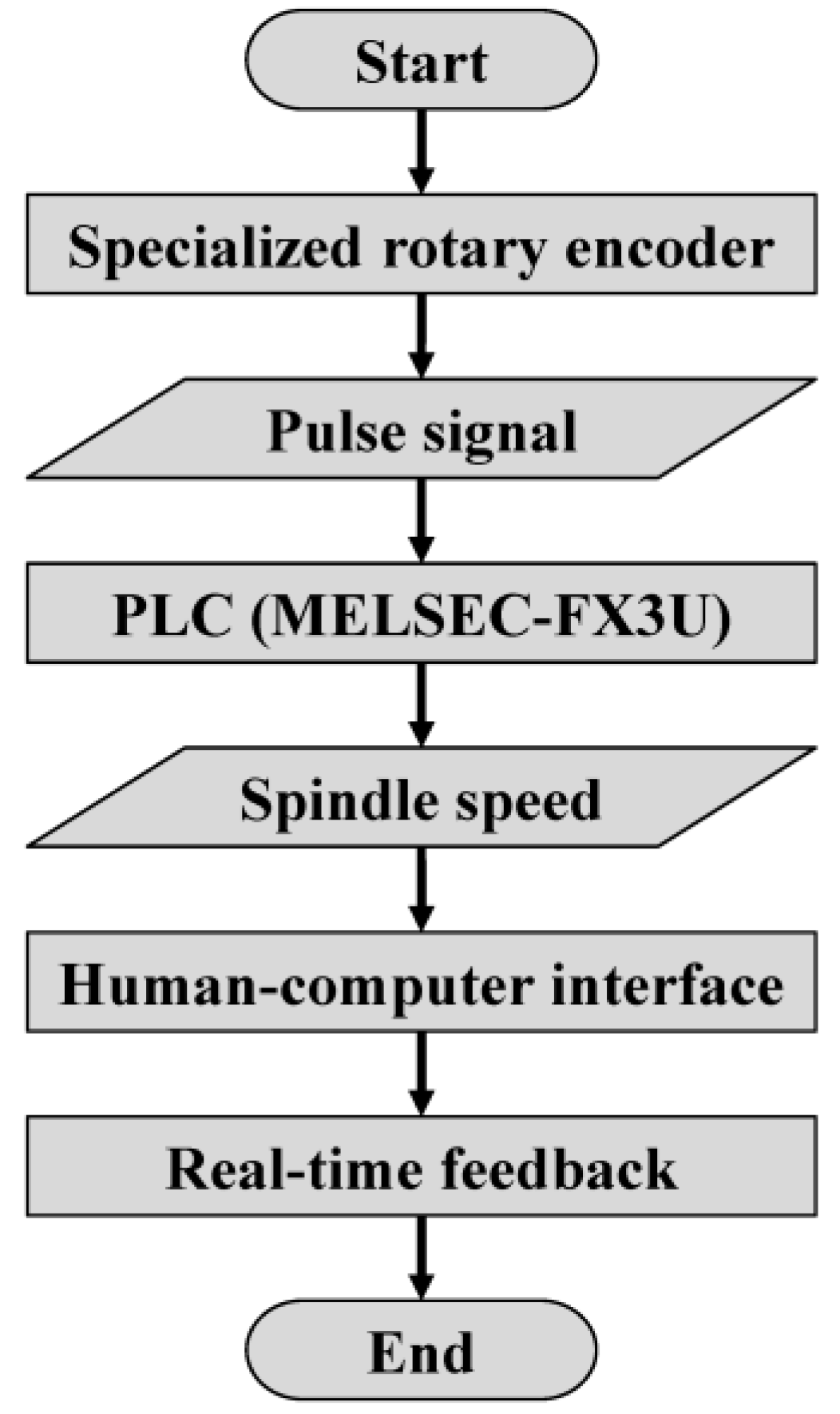


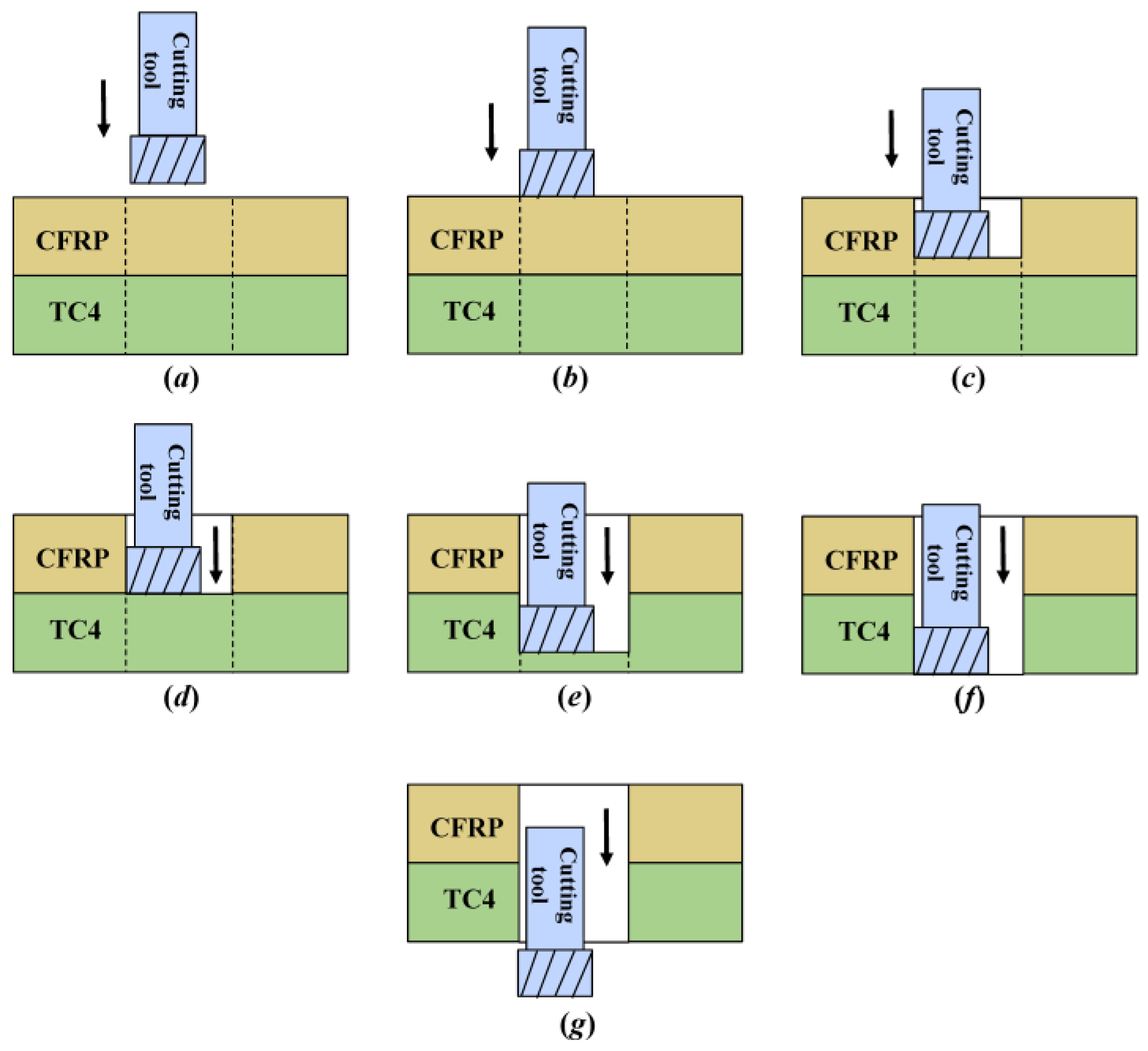
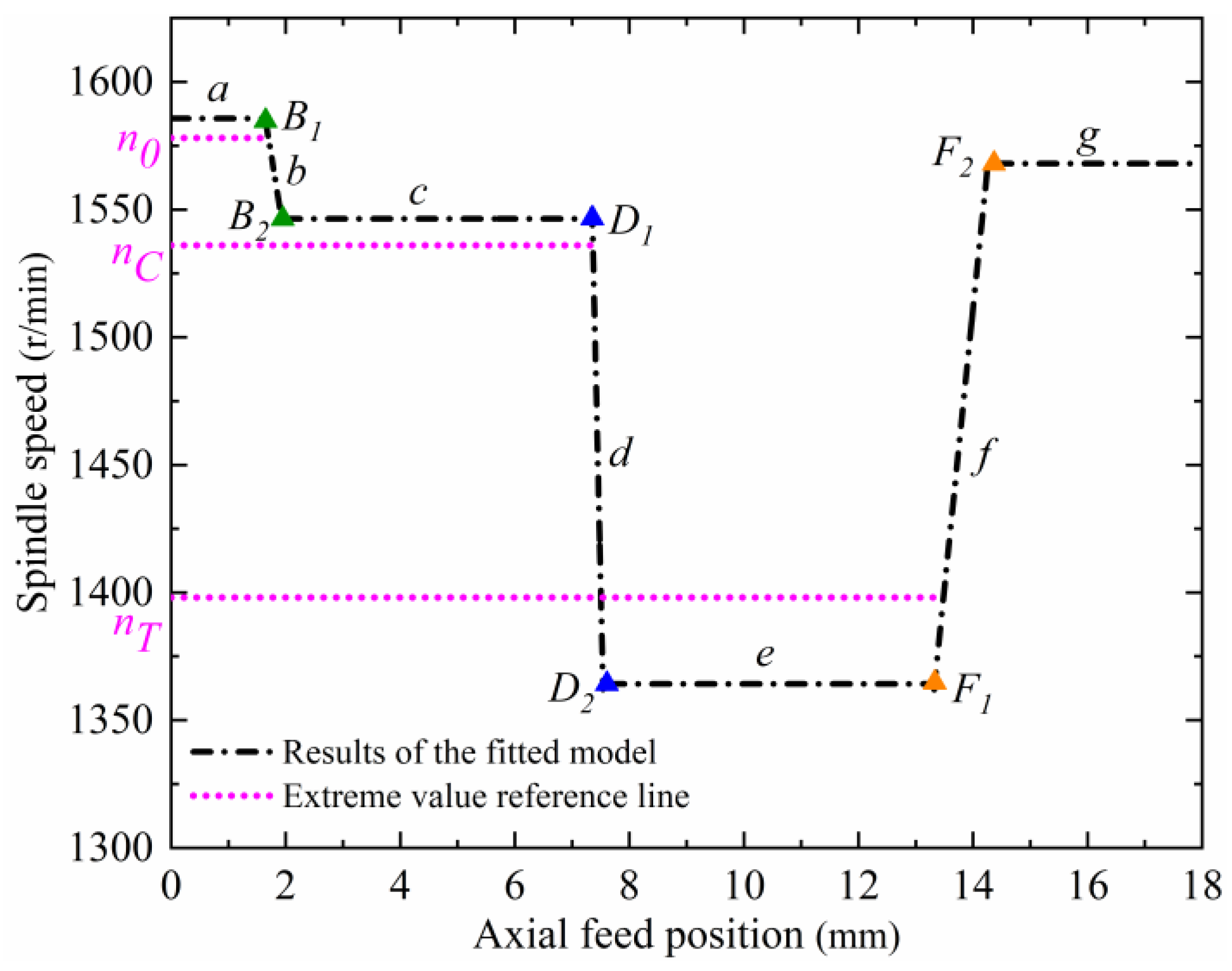
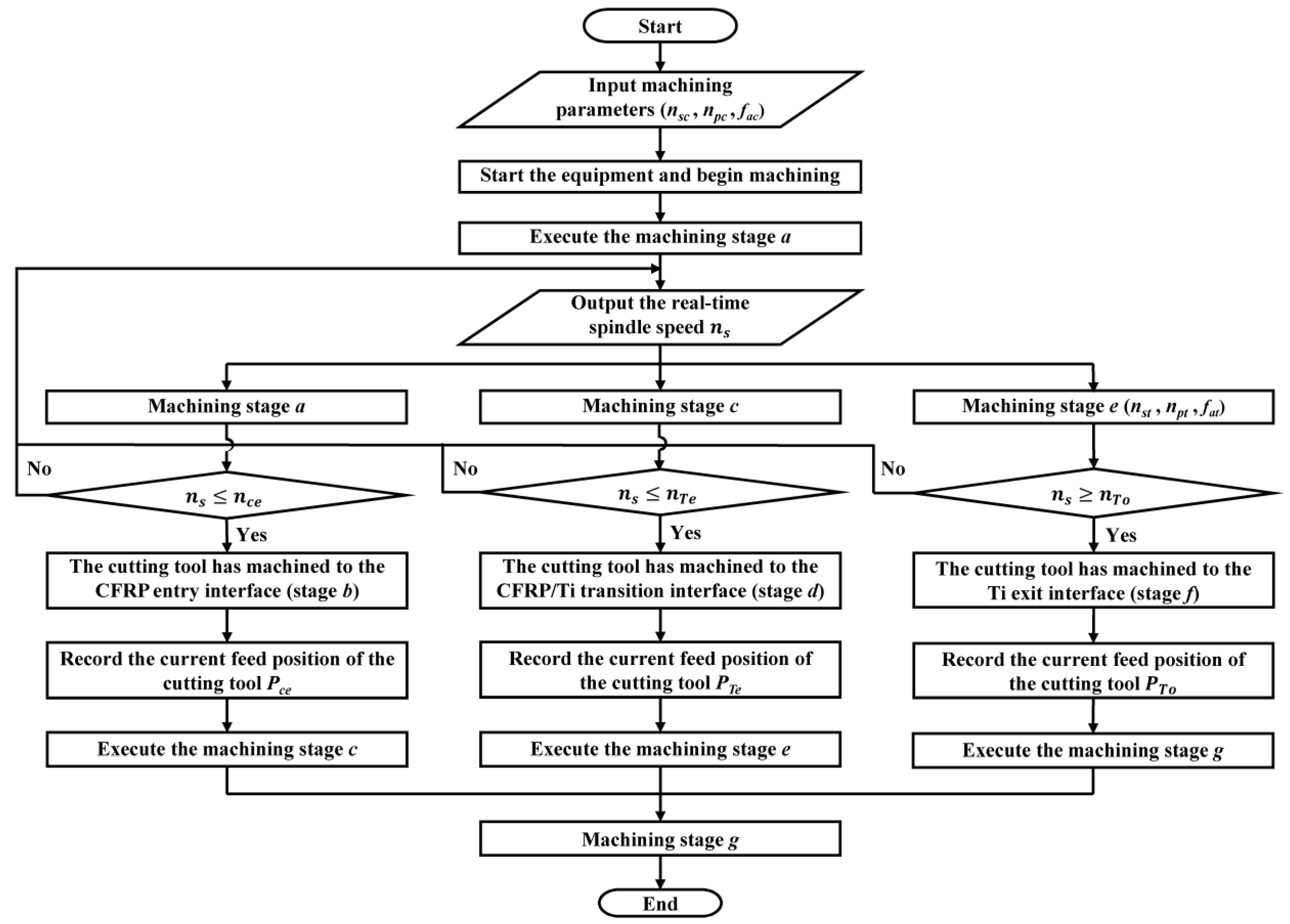

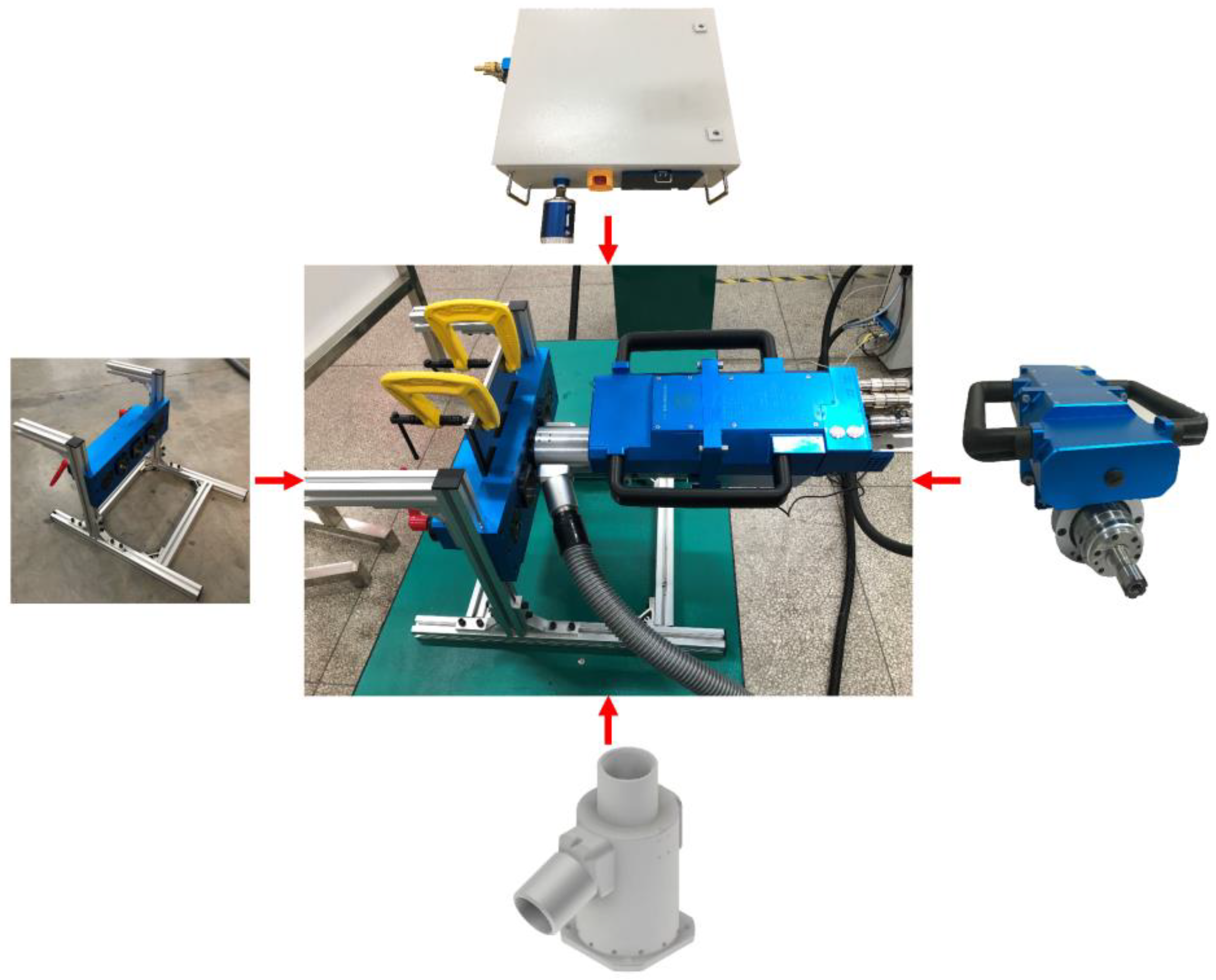
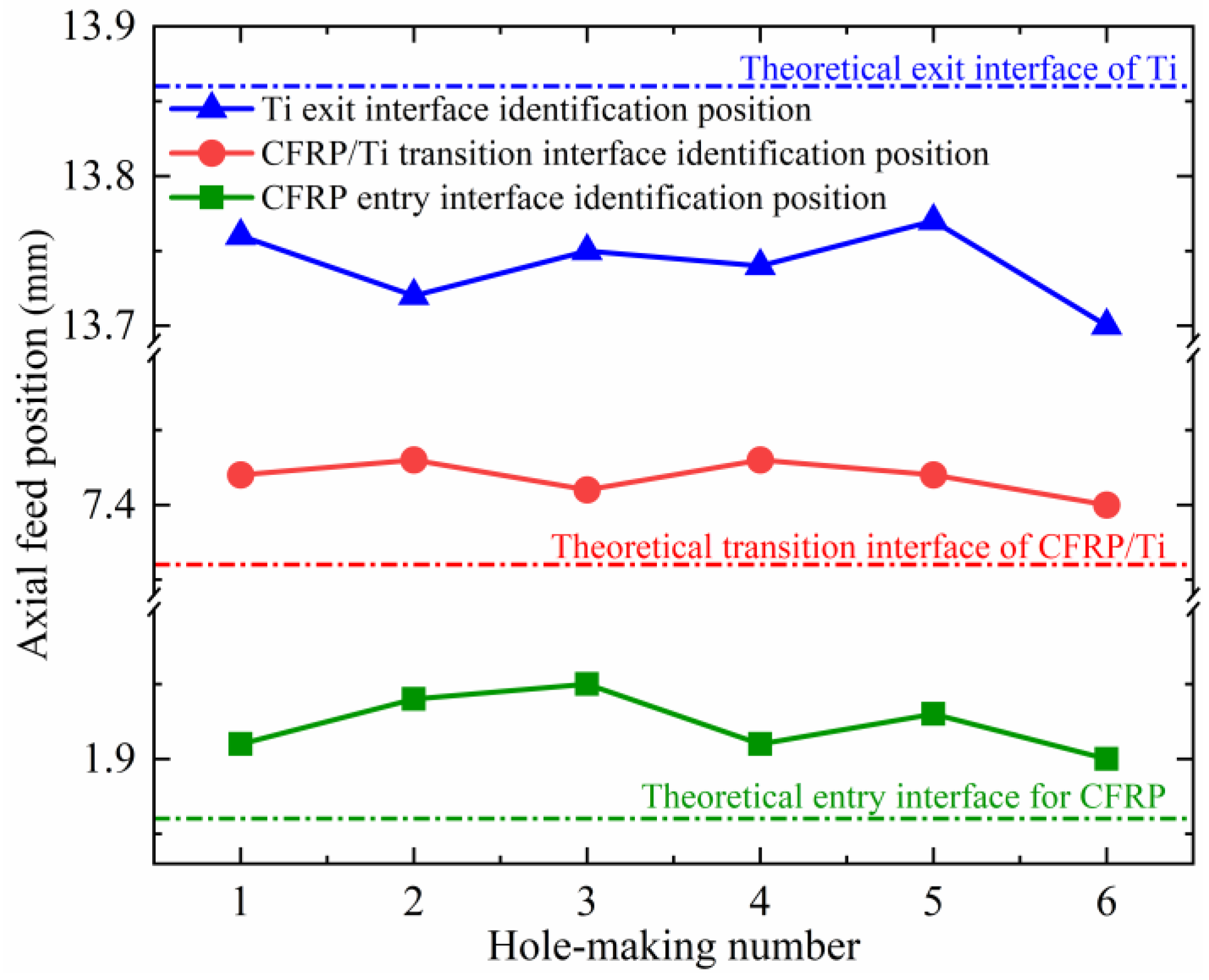
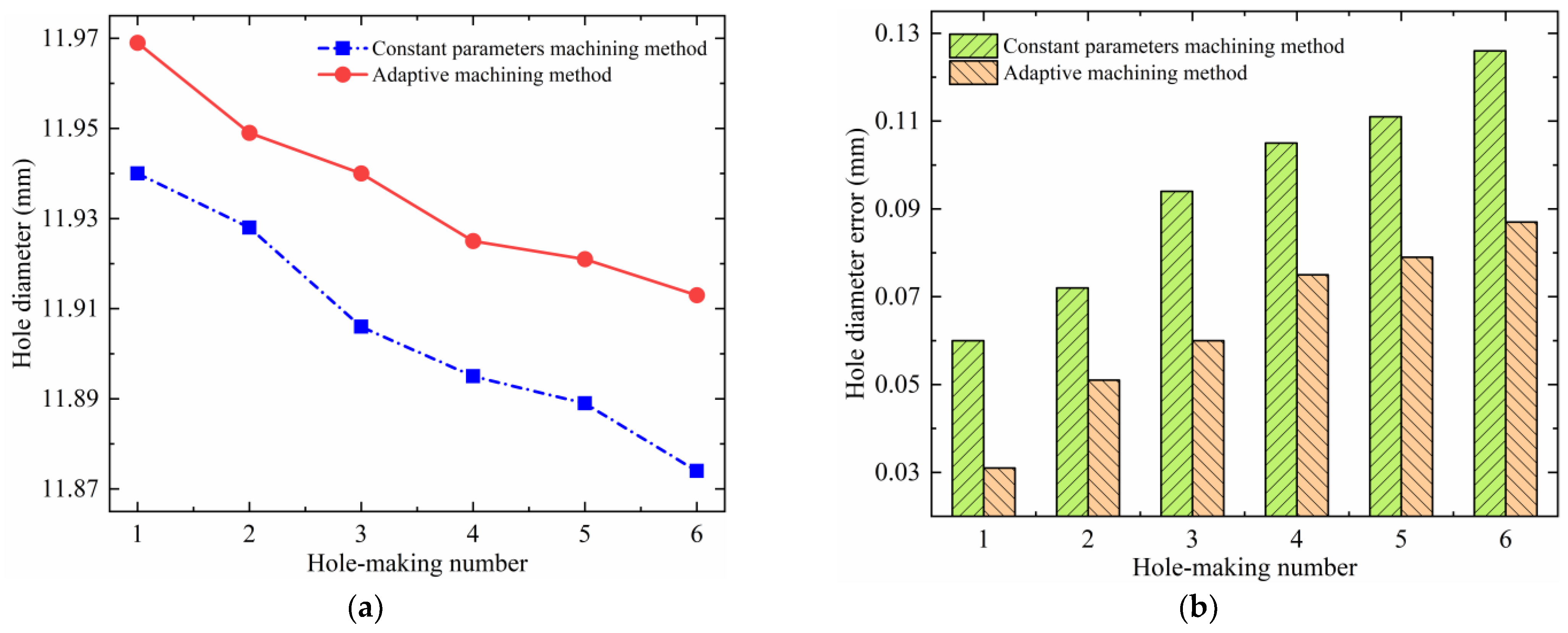
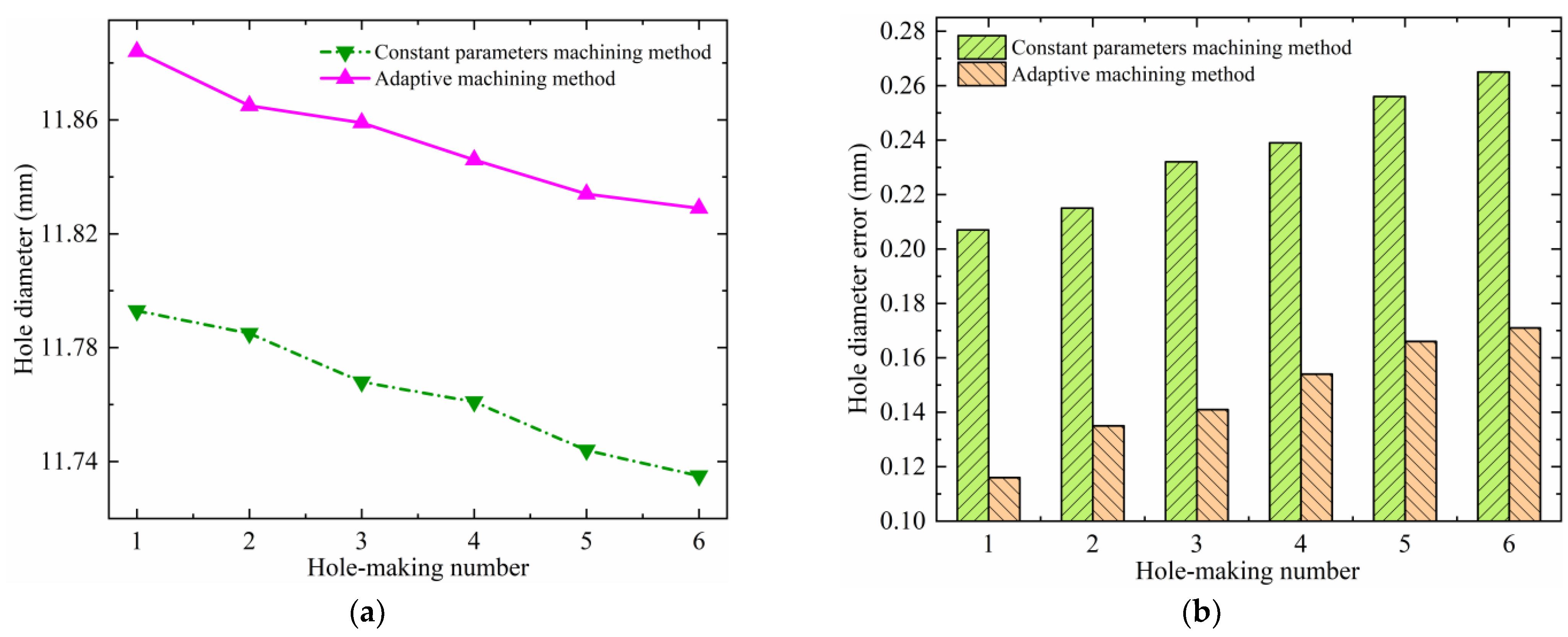
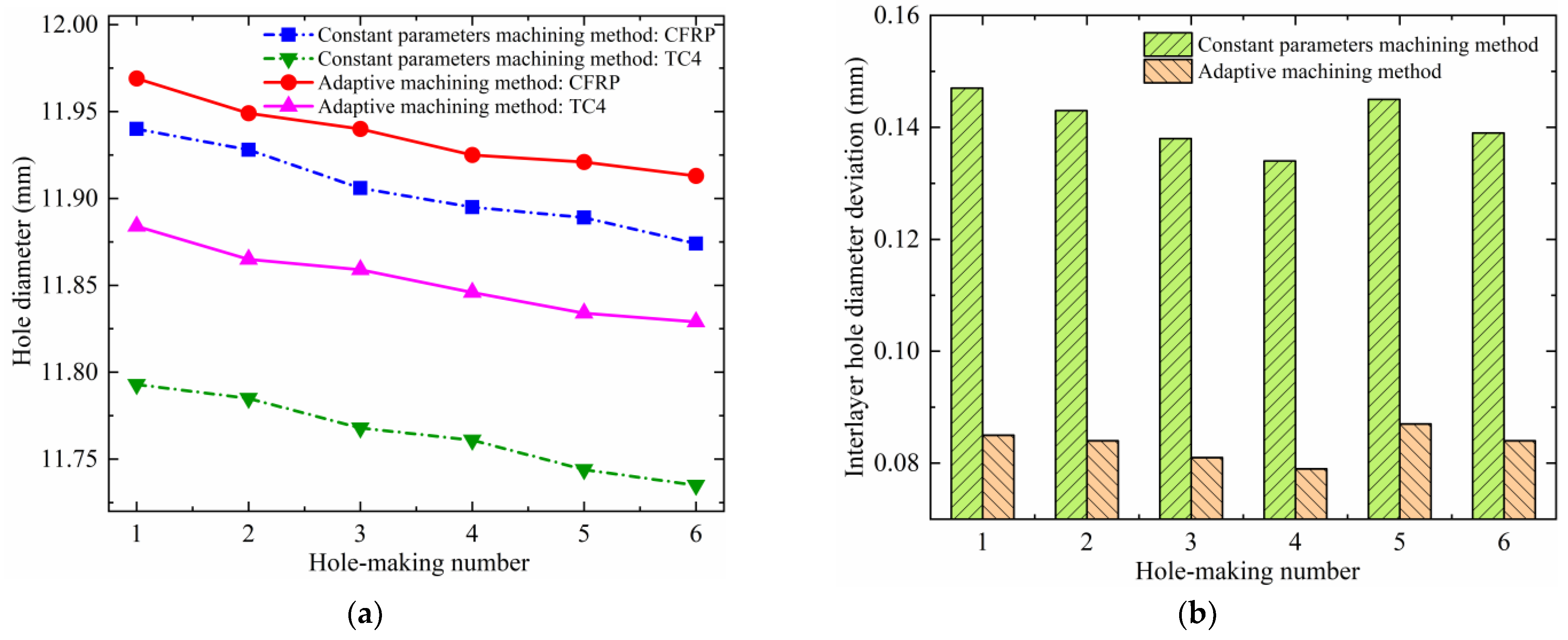
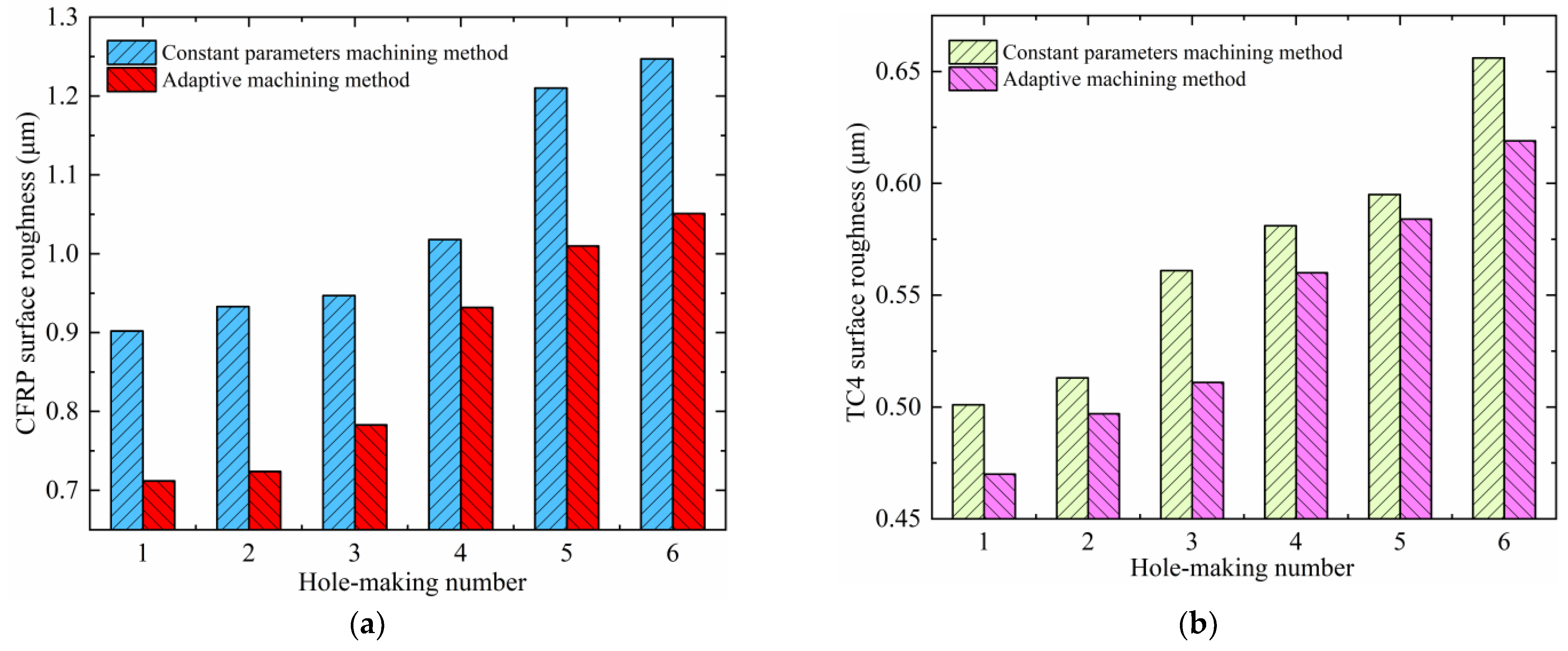
| ya~g | Model Parameter Ka~g | Model Parameter Na~g |
|---|---|---|
| ya | 0 | 1585.68 |
| yb | −137.65 | 1811.82 |
| yc | 0 | 1546.38 |
| yd | −989.7 | 8824.45 |
| ye | 0 | 1364.15 |
| yf | 219.25 | −1558.39 |
| yg | 0 | 1568.00 |
| CFRP Entry Interface (nCe) | CFRP/Ti Transition Interface (nTe) | Ti Exit Interface (nTo) | |
|---|---|---|---|
| Threshold value | 1575 r/min | 1516 r/min | 1402 r/min |
| Constant Parameter Machining Method | Adaptive Machining Method Based on Interface Identification | ||
|---|---|---|---|
| Constant Parameters (nsc, npc, fac) | Parameters of CFRP layer (nsc, npc, fac) | Parameters of TC4 layer (nst, npt, fat) | |
| Spindle speed (r/min) | 1600 | 1600 | 800 |
| Revolution speed (r/min) | 22 | 22 | 12 |
| Axial feed speed (mm/min) | 10 | 10 | 6 |
| Hole-Making Number | CFRP Entry Interface Identification Errors (mm) | Transition Interface Identification Errors (mm) | TC4 exit Interface Identification Errors (mm) |
|---|---|---|---|
| 1 | 0.05 | 0.06 | −0.1 |
| 2 | 0.08 | 0.07 | −0.14 |
| 3 | 0.09 | 0.05 | −0.11 |
| 4 | 0.05 | 0.07 | −0.12 |
| 5 | 0.07 | 0.06 | −0.09 |
| 6 | 0.04 | 0.04 | −0.16 |
| Entrance of CFRP | Exit of CFRP | Entrance of TC4 | Exit of TC4 | |
|---|---|---|---|---|
| Constant parameter method | 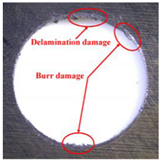 | 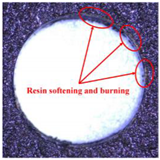 | 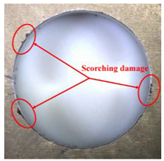 | 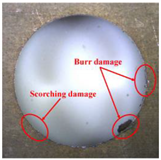 |
| Adaptive machining method | 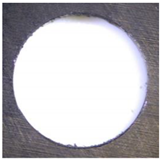 | 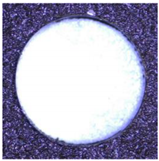 | 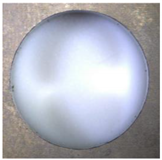 | 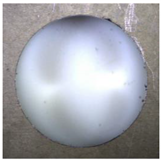 |
| Cutting Tool | ||
|---|---|---|
| Constant parameter method | 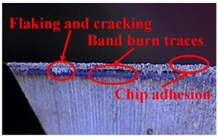 | 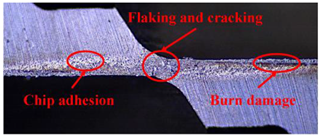 |
| Adaptive machining method | 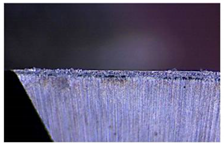 |  |
Disclaimer/Publisher’s Note: The statements, opinions and data contained in all publications are solely those of the individual author(s) and contributor(s) and not of MDPI and/or the editor(s). MDPI and/or the editor(s) disclaim responsibility for any injury to people or property resulting from any ideas, methods, instructions or products referred to in the content. |
© 2024 by the authors. Licensee MDPI, Basel, Switzerland. This article is an open access article distributed under the terms and conditions of the Creative Commons Attribution (CC BY) license (https://creativecommons.org/licenses/by/4.0/).
Share and Cite
Yan, C.; Kang, R.; Meng, F.; Dong, Z.; Bao, Y.; Yang, G. Adaptive Machining Method for Helical Milling of Carbon Fiber-Reinforced Plastic/Titanium Alloy Stacks Based on Interface Identification. Materials 2024, 17, 297. https://doi.org/10.3390/ma17020297
Yan C, Kang R, Meng F, Dong Z, Bao Y, Yang G. Adaptive Machining Method for Helical Milling of Carbon Fiber-Reinforced Plastic/Titanium Alloy Stacks Based on Interface Identification. Materials. 2024; 17(2):297. https://doi.org/10.3390/ma17020297
Chicago/Turabian StyleYan, Chao, Renke Kang, Fantong Meng, Zhigang Dong, Yan Bao, and Guolin Yang. 2024. "Adaptive Machining Method for Helical Milling of Carbon Fiber-Reinforced Plastic/Titanium Alloy Stacks Based on Interface Identification" Materials 17, no. 2: 297. https://doi.org/10.3390/ma17020297
APA StyleYan, C., Kang, R., Meng, F., Dong, Z., Bao, Y., & Yang, G. (2024). Adaptive Machining Method for Helical Milling of Carbon Fiber-Reinforced Plastic/Titanium Alloy Stacks Based on Interface Identification. Materials, 17(2), 297. https://doi.org/10.3390/ma17020297






